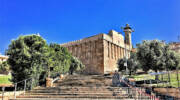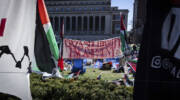An inscription found in the nineteenth century in one of the two great synagogues of Baram stated, “Peace be upon this place and upon all of the places of Israel.” It is currently on display at the Louvre in Paris. While one of the two synagogues of Baram is no more, the remnants of the other ancient Byzantine style synagogue are still there for all to see to this day. Indeed, a little over a year ago, I visited the ancient Byzantine synagogue of Baram with my husband and his family.
While there, I witnessed ancient Byzantine style columns standing upright and supporting a beautifully structured building that is testament to the fact that Jews continued to live in the Holy Land even after the brutal suppression of the Bar Kokhba Revolt in 135 CE. However, the center of Jewish life in Israel transferred from the Jerusalem area to the Galilee. Following the Bar Kokhba Revolt, 58 Jewish communities continued to exist in the Galilee, among them the Jewish community of Baram. Archaeological excavations have established that the village of Baram dates back to the Persian conquest of Israel around the 6th to 5th centuries BCE. During the Second Temple era, it was a large Jewish settlement. However, the great synagogue of Baram that one can still visit today is believed by archaeologists to be from the Mishna and Talmudic periods, although Rabbi Moses Basula stated in 1522 that this synagogue belonged to Simon Bar Yochaim who survived the Second Jewish War.
The Jewish village of Baram was a prosperous one, as demonstrated by the fact that its villagers built two synagogues. In 1210, Rabbi Shmuel bar Shimshon wrote about these two beautiful synagogues that were utilized in Baram. It was also mentioned in the Cairo Genizah, as well as medieval travel literature. The great synagogue of Baram’s Byzantine style columns are very similar to the architectural structures of Roman temples and Byzantine churches from around the same period of time. Near the window of the synagogue, an Aramaic inscription reads, “Built by Elazar son of Yuden (or Yudan).”
However, by 1522, the Italian Rabbi Moshe Basula claimed that the village was deserted, an assertion which was confirmed by Rabbi Moshe of Jerusalem in 1769. It is believed that the Jewish community in Baram came to an end around the Crusader period, although the fate of the Jewish villagers still remains a mystery. A Jewish prophesy from the 12th century maintains that the Jews were going to face destruction until they would be liberated by a savior. Nahman, the author of this prophesy, some believe to be buried within Baram as well. Indeed, the Jewish community of Baram faded from history, but in modern day Israel, there is a kibbutz nearby which bears the name of the ancient Jewish city of Baram.
As one visits Baram, one cannot help but be amazed at how much there is continuous Jewish history within the Land of Israel. Jews did not leave the Holy Land entirely following the suppression of the Bar Kokhba Revolt. To the contrary, Jews living in the Galilee maintained their attachment to their ancestral homeland and helped the Jewish people to maintain their faith and their unity, by producing the Palestinian Talmud. Despite facing persecution, these Jews clung to their faith and remained committed to the Land of Israel, despite the adversities that they faced. They truly understood and appreciated the mitzvah of living in the Holy Land.
By Rachel Avraham
Do You Love Israel? Make a Donation - Show Your Support!
Donate to vital charities that help protect Israeli citizens and inspire millions around the world to support Israel too!
Now more than ever, Israel needs your help to fight and win the war -- including on the battlefield of public opinion.
Antisemitism, anti-Israel bias and boycotts are out of control. Israel's enemies are inciting terror and violence against innocent Israelis and Jews around the world. Help us fight back!






















